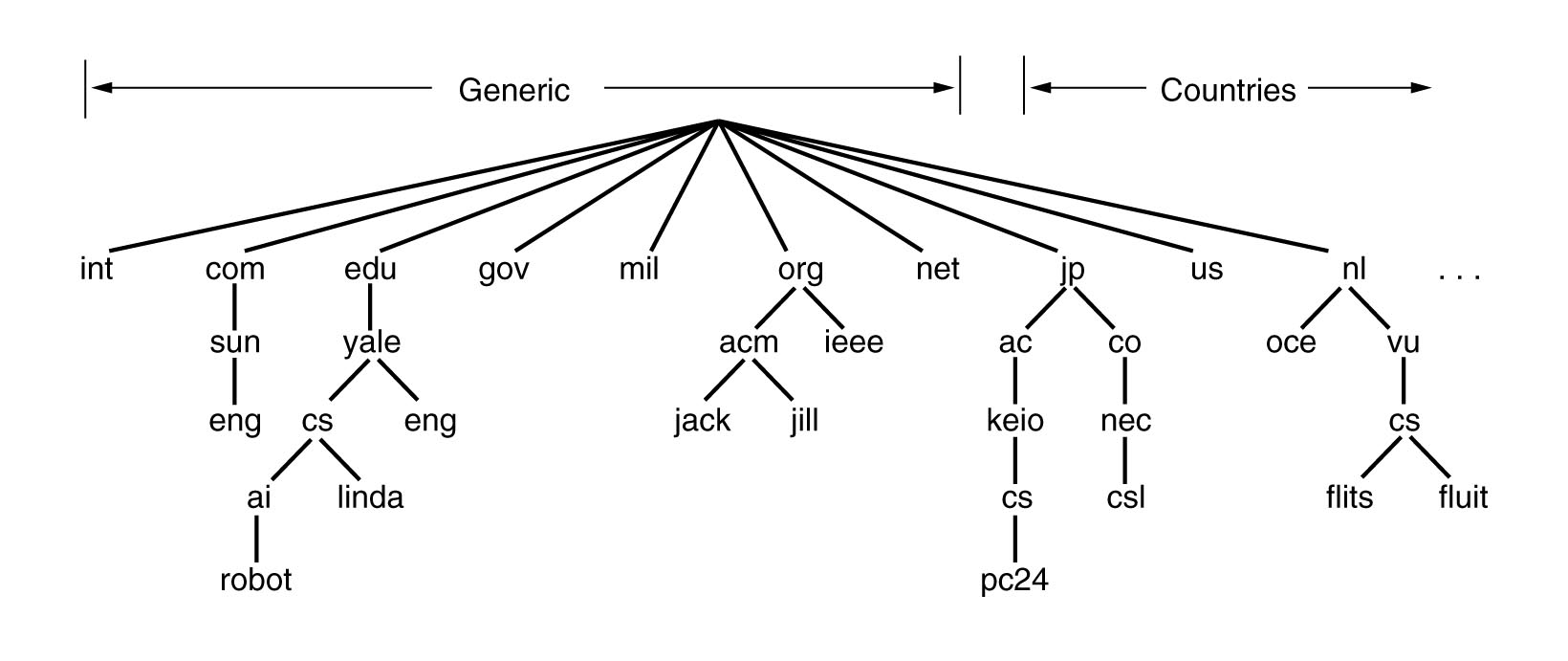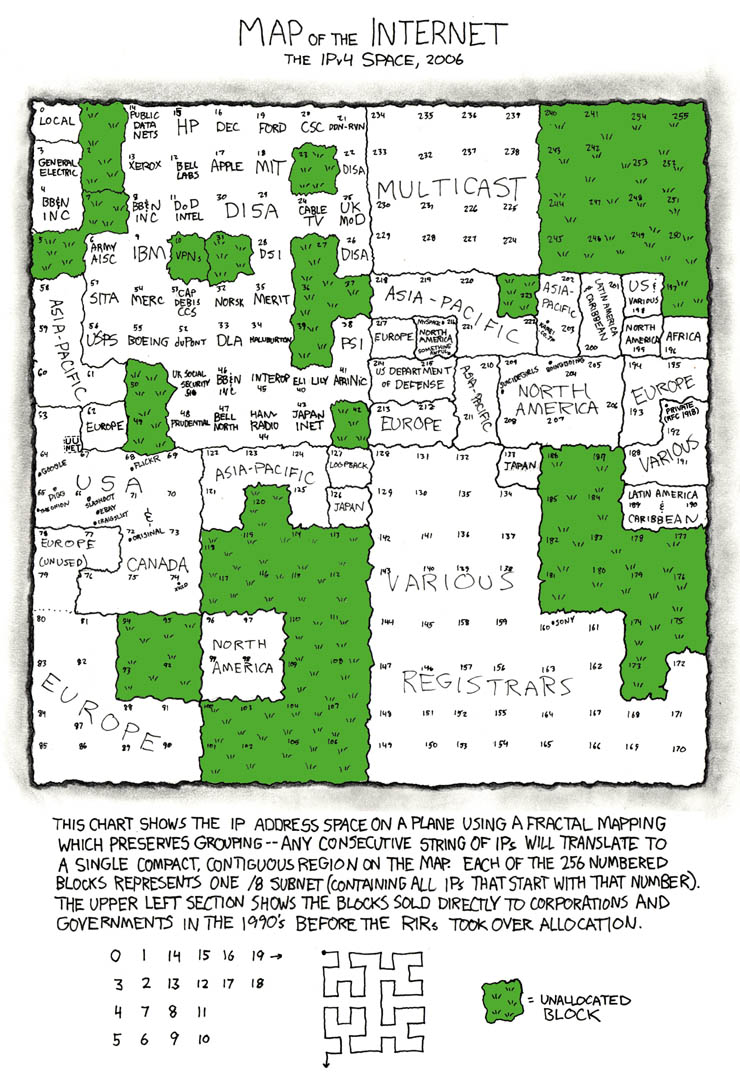Hosts and IP addresses
Machines have numbers that may (with some homework) describe their place
within the
network topology.
These are called IP addresses.
IP addresses under the standard
IPv4
look like:
106.132.204.106
Four
8 bit
numbers.
256
4 =
2
32
= 4 billion.
Humans could never work with these.
Since earliest days of networks, machines have
text names, which describe their place within
the logical hierarchy:
www.mit.edu
compsci.mit.edu
techpapers.compsci.mit.edu
Numeric - 4 parts.
Text - Can have variable number of parts.
Text syntax:
"In theory, this subdivision can go down to 127 levels deep,
and each label can contain up to 63 characters,
as long as the whole domain name does not exceed a total length of 254 characters.
But in practice some domain registries have shorter limits than that."
- ICANN
manages addressing.
It assigns chunks of the address space
to regional (e.g. international) authorities,
who then assign addresses in those regions.
Host or machine name
www.computing.dcu.ie
(actual machine).(organisation subdomains).(international subdomains)
fileserver.salesdivision.regionaloffice.company.co.uk
Case of machine name
is irrelevant.
(Case of the machine name part of a URL
is irrelevant.)
e.g. Using the
ping
tool at Unix command-line:
$ ping www.biscuits.com
www.biscuits.com is alive
$ ping WWW.BISCUITS.COM
WWW.BISCUITS.COM is alive
$ ping WWW.Biscuits.cOM
WWW.Biscuits.cOM is alive
$ ping www.biscuitss.com
ping: unknown host www.biscuitss.com
$ PING www.biscuits.com
PING: Command not found
The organisation can divide up its subdomains any way it likes.
The organisation gets allocated a certain number of addresses,
i.e. a subspace of the address space, such as:
126.121.*.*
and can assign these any names it likes.
It doesn't have to tell outside world (until an actual request is made).
See
DNS Lookup.

Domain name space.
I always wondered where "IE" for Ireland came from.
Why not "IR"?
Thanks to Feargal Fitzpatrick for helping work out the following story.
The story goes back to the 1920s.
- See
country codes for vehicles.
- 1924: Ireland adopted "SE" for vehicles in 1924 ("Saorstat Eireann").
- 1936:
Iran adopted "IR" for vehicles in 1936.
In retrospect, that was the moment Ireland lost it for the Internet.
- 1938:
Ireland switched to "EIR" for vehicles in 1938 ("Eire").
- 1962:
Ireland switched to the English version in 1962.
"IR" was taken,
so Ireland switched to "IRL", which it still has today.
- 1974:
The
ISO 3166
standard
defined
strictly 2 letter and
strictly 3 letter
country codes,
based on the country codes for vehicles.
Ireland therefore got "IRL" for its 3 letter code.
For the 2 letter code,
"IR" was taken,
so Ireland became "IE".
- 1985:
Internet country code top-level domains were defined in 1985, based on the ISO 3166
2 letter codes.
Hence we got the
.ie
domain.
-
See
1988 post
about the
registration of the
.ie
domain.
|
Network classes
(the old way of handing out IP addresses)
Map of IPv4 address space
From
xkcd
by
Randall Munroe.

- IPv4 address exhaustion
- CIDR
- Assigning blocks became more complex with CIDR in 1993.
- The network (or block) assigned can have any number of bits.
"CIDR notation" shows how many bits it has.
- DCU got its block under the old system (with small number of network classes).
- NAT
- On-the-fly translation from "internal" address spaces
inside an ISP/organisation
to externally-viewable IP addresses.
- Proxies - Check
what other sites see as your IP address
and it may show you using one of the
DCU proxies
rather than your actual IP address.
Yet the data goes back to you only, and not to all other users of the proxy.
- DCU uses real IP addresses internally,
but in fact your actual IP address need not be externally visible,
and hence could be anything.
With NAT, networks that previously required a reserved block of addresses
can be connected to the Internet with as little as a single IP address.
-
IPv6
- IPv6
has 128-bit addresses =
2128
= 340 trillion trillion trillion.
- Recall current IPv4 has 32-bit addresses =
232
= 4 billion.
My address is:
https://www.computing.dcu.ie/~humphrys/
(This is now a redirect to my site.)
This is an alias for the machine:
https://corno.computing.dcu.ie/~humphrys/
IP address
The host above translates to 136.206.217.26.
The following may not work.
It is complicated by tilde re-direction
and an
SSL cert.
https://136.206.217.26/~humphrys/
http://136.206.217.26/~humphrys/
https://136.206.217.26/
http://136.206.217.26/
Different forms of URL: student.computing.dcu.ie
My address is:
https://student.computing.dcu.ie/~mhumphrysdculab/
This is an alias for the machine:
https://razor.computing.dcu.ie/~mhumphrysdculab/
IP address
The host above translates to 136.206.218.15.
Again, the following may not work:
https://136.206.218.15/~mhumphrysdculab/
http://136.206.218.15/~mhumphrysdculab/
https://136.206.218.15/
http://136.206.218.15/

